Capybaras do not stack on top of each other in the wild. While they are social animals and often gather in groups, they do not exhibit behavior where they intentionally stack on top of one another.
Stacking Behavior
There is a popular belief that capybaras stack on each other to keep warm or sleep. However, this behavior has not been scientifically proven.
While capybaras are known to huddle together for warmth, there is no evidence to suggest that they stack on top of each other.
Capybaras are excellent swimmers and spend a lot of time in the water. They also roll in mud to cool down and prevent parasites.
When not swimming or rolling in mud, capybaras spend most of their time grazing on grass and other vegetation.
In conclusion, capybaras have a complex social structure and engage in various behaviors that are important for their survival.
While there is no evidence to suggest that they stack on top of each other, they are known to huddle together for warmth and engage in other social behaviors.
Myths vs. Facts
Common Misconceptions
Many myths surround the behavior of capybaras, including the idea that they stack on top of each other to stay warm.
While this may seem like a logical assumption, it is not true. Capybaras do not stack on top of each other in the wild or in captivity.
Another misconception is that capybaras are aggressive and dangerous animals. While they are large rodents, they are generally docile and prefer to avoid conflict.
They are herbivores with no natural predators, which may contribute to their relaxed demeanor.
Fact-Checking Capybara Behavior
Capybaras are social animals and live in groups, often consisting of several males and females. They communicate with each other through a variety of vocalizations and body language.
They also engage in grooming behaviors, which help to strengthen social bonds within the group.
Regarding staying warm, capybaras use a different strategy than stacking. They have a thick, waterproof coat that helps to insulate them from the cold.
They also spend a lot of time in the water, which helps to regulate their body temperature.
In conclusion, it is important to separate fact from fiction regarding capybara behavior. While they may not stack on top of each other, they have unique social behaviors and adaptation strategies that make them fascinating animals to study.




